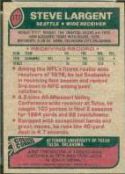Fred Taylor - 1998 SP Authentic 'Player's Ink' AUTOGRAPH (Jaguars)
Several sales by eBay dealers in the $22 to $30 range on eBay.
| Grade |
NM/MINT |
| Book Value |
$ 25 |
| Our Price |
$ 14.95
Add to cart
|


Below are short bits & pieces on sportscard & baseball trading card collecting.
Please wander around the website for more info, prices, values & images
on vintage baseball, football, basketball, hockey, sport and non-sports cards.


1977 Topps Football
The 1977 Topps Football set contained (528) cards.
The set was jam packed with rookies including:
Steve Largent, Lee Roy Selmon, Danny White...
Click for complete
1977 Topps Football Checklist and Prices
Note: You may be on that page right now.
|

1952,1953,1954,1955 Red Man TOBACCO
Checklist & Values
Tobacco cards were instrumental in the start of the baseball card industry
but were pretty much unheard of since 1920. That is until RED MAN TOBACCO
got in the game issuing baseball cards in 1952, 1953, 1954 & 1955.
For just 20 cents you got a pouch of Red Man tobacco and one awesome
3-1/2 x 4 inch baseball card with it's tab (3-1/2 x 3-5/8 without).
Exchange FIFTY tabs and you got one free big league style felt
baseball cap of your favorite team. This made cards with tabs much,
much harder to find and values 2 to 10 times higher.
25 players from each league were selected by "Sporting News" editor
J.G. Taylor Spink. A Player's artwork with different backgrounds
was used year after year. If a player changed teams, new team name
& logo were painted over the old one. To determine the year, just
subtract 1 from the expiration date on back of the card.
The 1954 set had four variations.
Click for complete
1952,1953,1954,1955 Red Man Tobacco cards checklist & prices
Note: You may be on that page.
|

1961 Topps Baseball Cards
Checklist & Values
The 1961 Topps baseball card set had 587 cards (#1-#598 with some missing numbers).
In addition to the missing cards, 2 cards were accidently numbered #463
(the Braves Team card was supposed to be card #426).
1961 Topps set was packed with special "subsets":
League Leaders (10 cards), World Series cards (10),
Highlights (11 cards), MVP's (16 cards), Checklists (7 cards plus several variations),
Team cards, Special Multi-Player cards, Managers,
Topps Rookie All-Star Trophies, & Sporting News All-Stars
Of note - 1961 Topps were the first cards bearing the very popular Topps Rookie All-Star Award Trophies.
"High Number" cards (#523-#589) are very scarce.
The least attractive aspect of the 1961 Topps baseball card set
were the capless players !!!
Baseball expansion led to the problem when
Los Angeles Angels were added,
the Washington Senators became the Minnesota Twins
and the Washington Senators got a new franchise.
Because of these changes, tons of players were capless
and looked awful. picture you 50 year old grand-dad.
Life was obviously tougher back then.
More 1961 Topps card info:
Card #1 was All-American basketball player Dick Groat
Card #2 was Roger Maris, right before his record breaking 61 Home Run season
Mickey Mantle was on (6) 1961 Topps cards adding to the sets cost.
Topps released 3 other sets in 1961: Topps Dice Game, Topps Magic Rub-Offs & Topps Stamps.
Click for complete
1961 Topps baseball cards Checklist and Prices
Note: You may be on that page right now.
Click for complete
1961 Topps Autographed baseball cards Checklist and Prices
|

Tobacco Cards
Starting approximately in 1886, sportscards, mostly baseball cards, were often
included with tobacco products, for promotional purposes and also because the
card reinforced the packaging and protected cigarettes from damage. These sports
cards are referred to as tobacco cards in the baseball card hobby. Over the next
few years many different companies produced baseball cards. Tobacco cards soon
started to disappear as the American Tobacco Company tried to develop a monopoly
by buying out other companies.
They were reintroduced in the 1900s, as American Tobacco came under pressure from
antitrust action and Turkish competition. The most famous and most expensive,
baseball card is the rare T206 Honus Wagner. The card exists in very limited
quantities compared to others of its type because Wagner forced the card to be
removed from printing. It is widely (and incorrectly) believed that Wagner did
so because he refused to promote tobacco, but the true explanation lies in a
dispute over compensation.
Soon other companies also began producing baseball and football cards. Sports magazines
such as The Sporting News were early entries to the market. Candy manufacturers
soon joined the fray and reflected a shift toward a younger target audience for cards.
Caramel companies were particularly active and baseball cards were one of the first
prizes to be included in Cracker Jacks. World War I soon suppressed baseball card
production.







